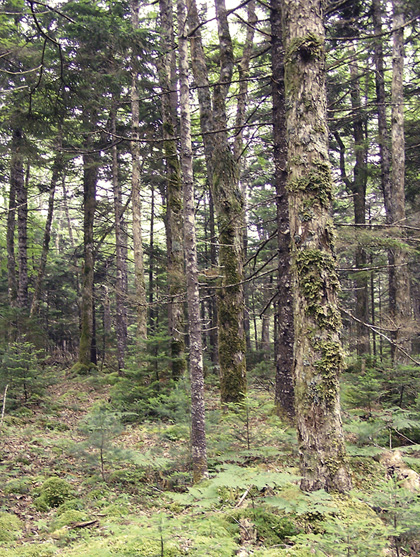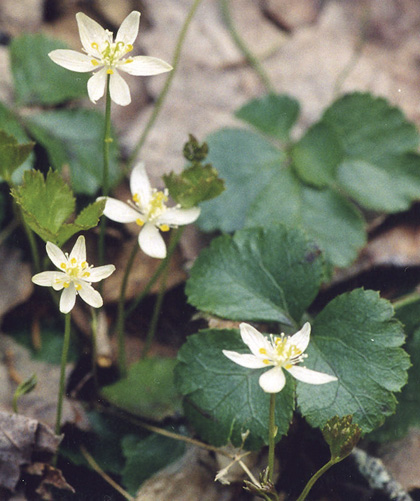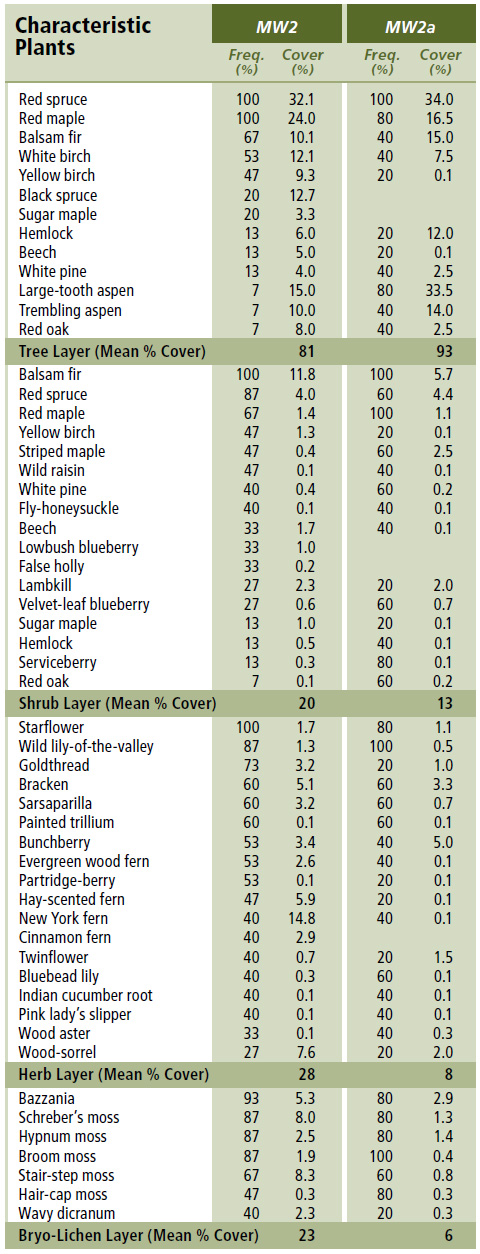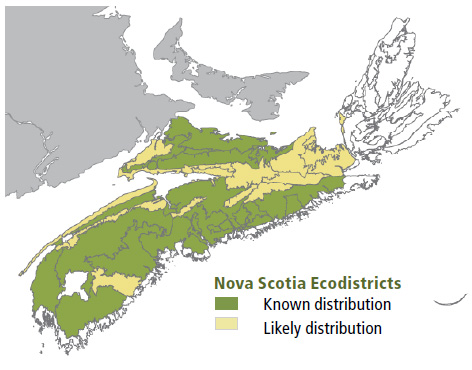
Forest Vegetation types - MW2
MW2 — Red spruce – Red maple – White birch / Goldthread
Picea rubens – Acer rubrum – Betula papyrifera / Coptis trifolia
MW2a — Aspen variant
Populus grandidentata – Populus tremuloides
 |
Tidney River Wilderness Area, Queens County |
Concept: This mid-successional mixedwood Vegetation Type (VT) has an overstory co-dominated by red spruce and red maple, accompanied by lesser amounts of various other trees. There is one variant (MW2a) where aspen (trembling and/or large-tooth) co-dominates with spruce and maple. MW2 usually occurs as a result of partial harvesting or windthrow. It is a common mixedwood VT found throughout mainland Nova Scotia.
Vegetation: Red spruce and red maple are the dominant overstory trees, with either trembling or large-tooth aspen co-dominant in variant MW2a. Several shade-tolerant trees (e.g. sugar maple, beech, white pine, hemlock) are typical but lesser overstory species. The shrub layer is moderately developed and includes mainly regenerating trees, striped maple and fly-honeysuckle. The herb layer is represented by typical mixedwood forest flora, however species normally associated with poorer sites (e.g. bracken, bunchberry and goldthread) are more common in MW2 than they are in yellow birch mixedwood VTs (MW1 and MW3). Bryophyte development varies, with coverage directly related to relative softwood abundance in the overstory. Schreber's moss and stair-step moss are the main species. Bazzania can also be common where coarse woody debris has accumulated on the forest floor.
Environmental Setting: MW2 is mainly associated with fresh to fresh-moist, nutrient medium soils of variable texture. This VT occurs on mainland Nova Scotia wherever red spruce forests are found. It is common throughout New Brunswick but rare on Prince Edward Island.
Successional Dynamics: MW2 is a mid-successional VT that follows partial stand disturbances such as windthrow and harvesting. Earlier successional VTs may include IH4 (Trembling aspen / Wild raisin / Bunchberry) and IH6 (White birch – Red maple / Sarsaparilla –Bracken). Later successional VTs include SH3 (Red spruce – Hemlock / Wild lily-of-the-valley), MW1 (Red spruce – Yellow birch / Evergreen wood fern) and MW3 (Hemlock – Yellow birch / Evergreen wood fern). Early successional stages can be by-passed if, at the time of disturbance, advanced red spruce regeneration is present and maintained. Depending on disturbance history, this VT can be even-aged, but it will develop an uneven-aged structure as it matures. Residual trees in the overstory can provide evidence of pre-disturbance conditions and should be considered when assessing possible successional trends.
Ecological Features: This closed canopy forest typically occurs as large patches following stand or patch-scale disturbances such as clearcutting or partial harvesting. Red maple regeneration is by seed or coppice. This ecosystem provides several ecological functions including the facilitation of nutrient cycling, rapid site revegetation after disturbance, and the establishment of nurse crops for later successional species such as red spruce, hemlock and yellow birch. Residual trees from early successional stages are common and may provide notable wildlife habitat values and increased forest structural complexity. Large trees can provide nest sites for pileated woodpeckers, barred owls and northern goshawks. Downed coarse woody debris may provide cover for red-backed salamanders and small mammals. Mixedwood forests may also provide both shelter and food for overwintering deer.
 |
| Goldthread (John Gillis) |
Distinguishing Features: Red spruce and early successional species such as red maple, white birch and aspen occur in this mixedwood forest on well drained soils. For the variant MW2a, aspen replaces much of the red maple. Bracken fern, bunchberry and goldthread are common.
| Slope Position: | Crest2 Lower2 Middle2 Upper2 Other1 nd1 |
Surface Stoniness: |
(Non - Slightly)5 (Moderately)3 (Very - Excessively)2 |
Bedrock Outcrop: |
(Non-rocky)9 (Slightly - Moderately)1 |
Elevation Range: |
24 - 211m |
Slope Gradient: |
Gentle3 Level2 Other1 nd1 |
Aspect: |
North3 East1 South1 West3 None1 nd1 |
Exposure: |
Moderate6 Mod. exposed3 Mod. sheltered1 |
Microtopography: |
Moderately4 Slightly2 Strongly2 Level1 nd1 |
Drainage: |
Moderately well5 Imperfect2 Well2 nd1 |
Soil Type: |
ST23 ST3-L2 ST62 ST2-G1 ST31 Other1 |
Parent Material: |
Glacial till10 |
Rooting Depth (cm): |
(<30)3 (30-45)3 (>45)4 |
Duff Thickness (cm): |
(0-5)1 (6-10)5 (11-20)3 nd1 |

